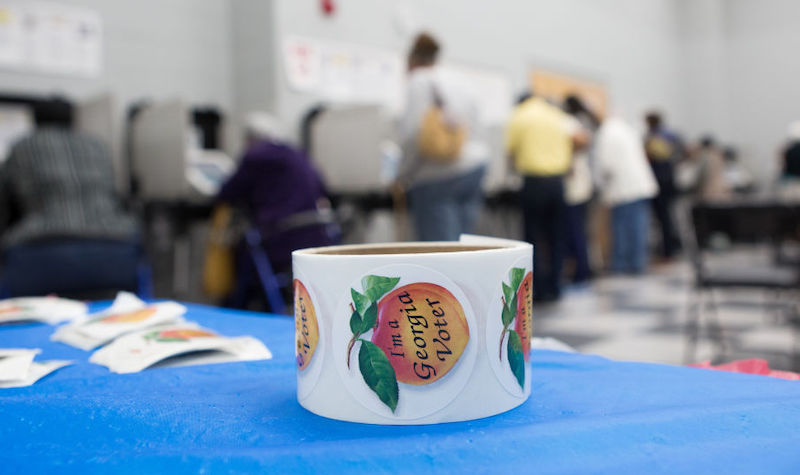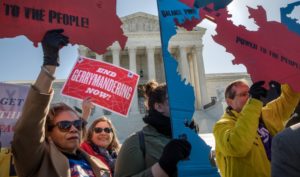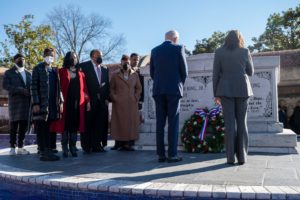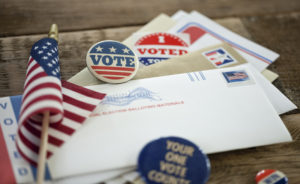
Voters, lawyers, and activists continue to fight for voting rights in the Peach State.
“A rampant war is being waged against minorities’ voting rights in my home state of Georgia and across the nation,” the late U.S. Representative John Lewis wrote on June 25, 2020—one of his last public statements.
A few months later, voters from across Georgia, including Black voters, turned out in record numbers to participate in a presidential election. They did so even though Georgia historically—and still today—deliberately makes it difficult for them to cast a ballot that will be counted.
The outcome of the November 2020 election in Georgia reflected more than the determination and will of voters across the state. It also took armies of lawyers and activists fighting to protect the right to vote.
Nearly a century after the Fifteenth Amendment granted Black men the right to vote, Black voters in Georgia remained largely disenfranchised in 1965. “Colorblind” measures such as literacy tests and other complicated voter registration procedures—purportedly designed to combat voter fraud—were enormously successful in preventing Black Americans from voting.
Black Americans organized and peacefully protested, demanding that their right to vote be protected and enforced. In one demonstration, John Lewis and 600 marchers attempted to cross the Edmund Pettus Bridge on one fateful Sunday in March of 1965. Alabama state troopers stopped them violently—attacking, teargassing, clubbing, and spitting on marchers. Lewis suffered a fractured skull after a state trooper struck him with a nightstick.
As a result of Lewis and others’ heroic efforts, Congress passed the Voting Rights Act of 1965 (VRA), which outlawed blatant discrimination as well as certain “colorblind” tactics that restrict voting. Congress also required jurisdictions with a history of discriminatory voter suppression—such as Georgia and its political subdivisions—to get approval from the federal government before making changes to election laws or procedures—a process known as “preclearance.” For years, the federal government often objected to Georgia’s proposed changes to election laws because they were clearly discriminatory in intent or effect. The number of African Americans who registered and voted increased significantly.
But in 2013, the U.S. Supreme Court effectively removed the preclearance requirement. Shelby County v. Holder left Georgia free to implement voting law changes without providing notice and without demonstrating to the federal government that proposed changes would be non-discriminatory in purpose and effect.
Since 2013, Georgia has implemented more voting restrictions reminiscent of the “colorblind” tactics of the earlier era. The U.S. Commission on Civil Rights found that, among the states previously subject to preclearance under the VRA, Georgia was the only state that had implemented voting restrictions in every category the Commission examined: strict voter ID requirements; documentary proof of U.S. citizenship; purges of voters from registration rolls; cuts to early voting; and closed or relocated polling locations. All of these restrictions would have been subject to preclearance and likely blocked by the U.S. Department of Justice.
Five years after Shelby County, Stacey Abrams, the first Black female major-party gubernatorial nominee in the United States, lost an election for Georgia governor by less than 55,000 votes—a race that many believe she would have won had it not been for racially-motivated voter suppression.
Abrams’s opponent and the current Georgia governor, Brian Kemp, served as secretary of state shortly before the preclearance requirements were eliminated until two days after the gubernatorial election that he both oversaw and competed in against Abrams.
One controversial policy Kemp enforced was an “exact match” policy. Under exact match, if a new voter’s application did not perfectly match information in other government files, the secretary of state could ultimately reject that voter’s registration. Even a missing hyphen or typographical error by a government employee could be fatal for registration under the guise preventing voter fraud.
In 2009, under then-governing preclearance requirements, the Justice Department objected to a proposal from Georgia to adopt an exact match policy, finding that it presented “real, substantial,” “retrogressive” “and erroneous” burdens on voters of color. The Justice Department approved a modified administrative policy with safeguards in 2010, but it is unclear whether Kemp implemented those safeguards. Following the 2016 election, Kemp entered into a federal settlement with civil rights groups who had proved that his policy, in practice, had disproportionately prevented voters of color from registering in the past two election cycles.
Shortly after the settlement, though, state legislators passed a legislative version of the exact match policy, codifying the practice in 2017 and leading to 53,000 suspended voter registrations, mostly for voters of color. Although Georgia’s population is approximately 32 percent Black, the list of voter registrations on hold with Kemp’s office was approximately 70 percent Black. 80 percent of Georgia voters blocked by exact match were people of color.
Voters who were able to register struggled to remain on the voter rolls in 2018 as the state purged more than 1.4 million Georgians from the voter rolls. On a single night in 2017, Kemp struck over half a million people—approximately 8 percent of Georgia’s registered voters—from the voter rolls. The Atlanta Journal-Constitution called it the “largest mass disenfranchisement in U.S. history.” Kemp said he was safeguarding the election from fraud. But black voters’ registrations were canceled at a higher rate than white voters.
Kemp purged many of these voters from the rolls through his aggressive use of Georgia’s “use it or lose it” law, which permits the state to use registered voters decisions not to vote in a recent election as a trigger for removing them from the rolls even though they had been registered. Like exact match procedures, the Justice Department had objected to similar prior proposals for “use it or lose it” under preclearance.
In addition to purging voter rolls, Georgia changed its voting processes in the years leading up to 2018. County and state officials closed more than 200 polling places, primarily in poor and minority neighborhoods. During this time, then-Secretary of State Kemp encouraged counties to consolidate voting locations, emphasizing that, because of Shelby County, counties no longer needed to submit changes to the Justice Department for preclearance. Poll closures accelerated. As a result, precinct closures and the need to travel longer distances to vote likely prevented an estimated 54,000 to 85,000 voters from voting on Election Day in 2018, according to the Atlanta Journal-Constitution.
Many of the remaining polling places had too few—and often malfunctioning—voting machines, even though hundreds of available machines sat unused in government warehouses. Some voters, particularly in majority Black neighborhoods, waited in line to vote for more than four hours.
Voters who were able to reach their polling places and remain in line for long periods then faced the possibility that they would not be found on the voter rolls. Although Georgia law requires election officials to provide provisional ballots to any voters whose registration could not be confirmed, many poll workers did not understand that requirement, refused to comply, or ran out of provisional ballots.
Voters also reported problems with absentee ballots—including the state’s failure to notify voters of problems with their ballots that could have been fixed in time for their votes to be counted. Once again, these problems had a disproportionate impact on voters of color. In Gwinnett County, for example, where over 60 percent of residents are Latino, Black, or Asian American, officials rejected absentee ballots at a rate more than three times the statewide average.
In the face of these systemic challenges, Abrams lost her bid for the governor’s mansion by the slimmest of margins. “I sat shiva for 10 days,” Abrams said. “Then I started plotting.”
Abrams’s new group, Fair Fight, filed a lawsuit in federal court arguing that the cumulative effect of Georgia’s voting system had been to deprive Georgia citizens, especially citizens of color, of their right to vote—and asked the court to put Georgia back under preclearance under a rarely used section of the VRA.
Since Shelby County, voting rights advocates have used tools such as Section 2 of the VRA to bring successful lawsuits against Georgia demonstrating that the state’s actions in regulating voting were racially discriminatory. But Section 2 puts the burden on voters to prove that a law has a discriminatory result or purpose. These lawsuits are expensive, complicated, and often span several election cycles. In the years during a case’s pendency, voters are effectively disenfranchised. Even in “successful” cases, voters cannot get back their earlier votes.
What is more, the state can—and, in Georgia’s case, has—either implemented slightly tweaked versions of the same policies that courts have found to be racially discriminatory or just replaced a blocked policy with another racially discriminatory policy. Without the preclearance process, nothing prevents states from continuing to implement these kinds of changes—even if those changes are later challenged and struck down in court.
This problem is not new. When Congress enacted the VRA, it knew that, since the end of Reconstruction, whenever one type of discrimination had been blocked, another came along to take its place. For this reason, Congress designed the preclearance process to block discriminatory laws before they could take effect and, therefore, before they could harm minority voters.
As Abrams explained in Georgia in 2018, “we know empirically that preclearance would have permitted more voters to cast their ballots because the policies that denied them the right to vote would not have been enacted.”
The current legal tools available to protect voters’ rights—especially those of Black voters—are insufficient and often ineffective. Preclearance remains vital.
Nevertheless, in the absence of preclearance, advocates and organizers redoubled their efforts ahead of the 2020 election—knocking on doors, registering voters, and continuing to challenge election practices in court.
Under this pressure, Georgia changed many of its election laws and practices. Judges ordered some of the changes. The state legislature also made changes to several laws that were at the center of ongoing litigation.
As a result, Georgia voters faced fewer barriers in 2020. It took three federal lawsuits, but Georgia election officials can no longer automatically flag voter applications for rejection due to typographical errors, for example. Under a revised “use it or lose it” law, the state must wait for a longer period of time and provide additional notice before it can cancel voter registrations. Absentee voters also received new protections in 2020, including a cure process to fix minor mistakes.
Despite these victories for voters, many administrative and legal barriers still prevent some Georgians from being able to exercise their right to vote. In 2019, for example, Georgia Secretary of State Brad Raffensperger canceled over 120,000 voter registrations under the use-it-or-lose-it policy. Voting rights groups allege that nearly 200,000 voters were removed improperly. Raffensperger denies this claim, and the dispute is the subject of ongoing litigation.
As state officials continue to try to make it hard to vote, or neglect to change rules to allow voters to vote during a pandemic, lawyers have fought back, time and again.
In the first week of early voting in the 2020 general election, some Georgians waited in line for over 11 hours. ProPublica found that lines to vote in Georgia were still longer in predominantly Black neighborhoods than in white ones. Adding to complications, within the 48 hours before the election, state election officials changed over a hundred polling locations.
Both Georgia election officials and voting rights advocates do agree that Election Day 2020 was better than it had been in 2018. In the end, 1.2 million Black voters in Georgia cast a ballot, an increase of 500,000 compared to 2016.
But voting rights are not secure in Georgia. As John Lewis, Stacey Abrams, and others have demonstrated, vigilance is key, and lawyers and activists in Georgia still need to continue to fight for suffrage. Likewise, Georgia’s secretary of state—still claiming to be concerned about voter fraud—is leading a “full-scale investigation to combat illegal voting” and launching a new investigation into several groups that have been working to organize and register voters.
The November 2020 election led to two U.S. Senate runoff elections in Georgia. Tomorrow, the voters of Georgia will decide which party controls the upper chamber.



